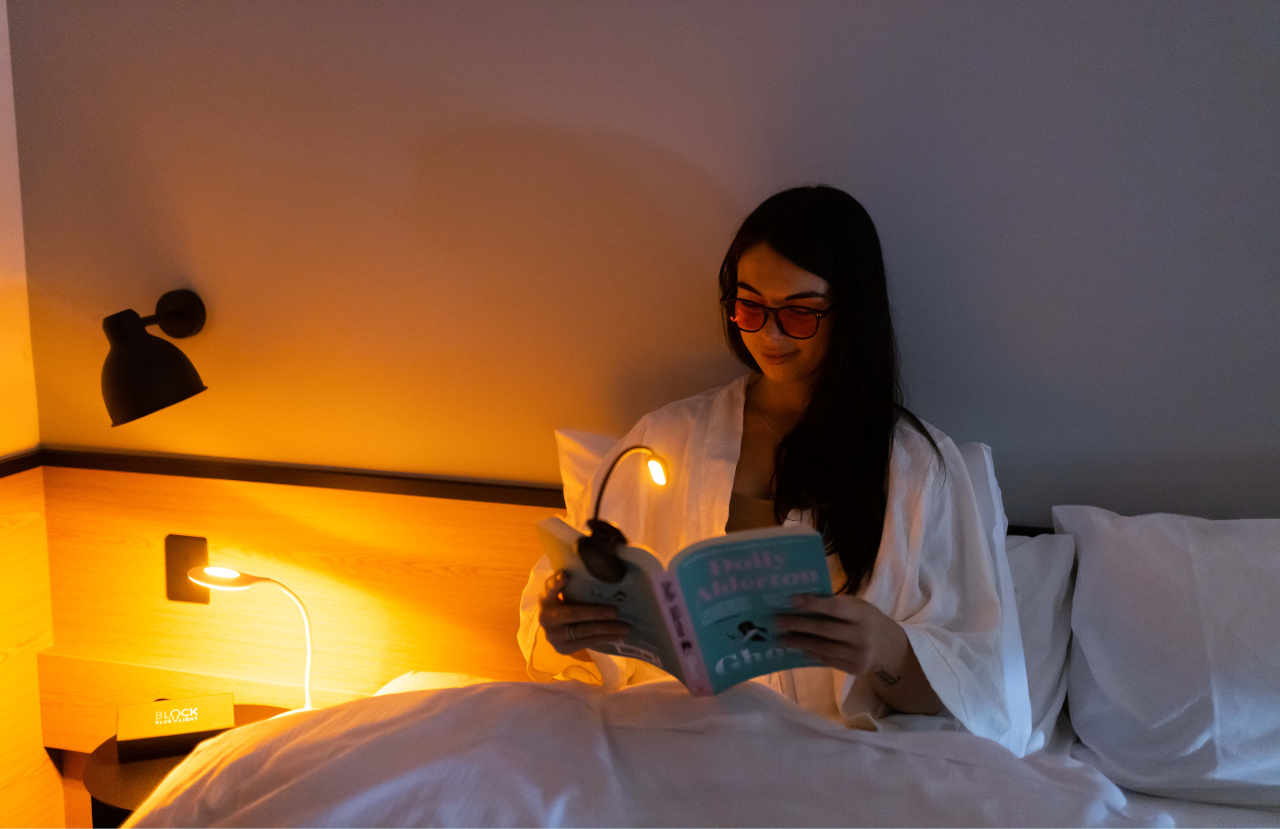If you struggle with insomnia, jet lag, or other sleep issues, we have some great news about blue light and circadian rhythms that could provide some insight into how to improve the quality of your sleep.
Our circadian rhythms have been explored in a ground-breaking study, providing fresh insights into the connection between blue light and sleep-wake cycles. This piece will examine what this new research on blue light and circadian rhythms means for you and how it could benefit your health.
Jump to Section
- Blue Light & Circadian Rhythm Science
- The Role of Cryptochromes, Genetic Feedback Loop & Blue Light
- What is Blue Light & Its Role?
- Unraveling the Mystery of TIM
- Further Implications From This Research
- What Does This Mean for You?
Blue Light & Circadian Rhythm Science
The internal biological clocks known as circadian rhythms control our sleep-wake patterns and other vital physical processes. They are essential to preserving our health and wellbeing. Think of them as an orchestra where the different parts (genes, proteins, and light sensors) play together to create our sleep cycle, a lovely symphony.
These cycles are present in every living organism, including plants. A recent research, published in the journal Nature has investigated the circadian rhythm photosensor and its target in fruit flies. These little insects make excellent research subjects because they closely resemble our circadian rhythms.

The Role of Cryptochromes, Genetic Feedback Loop & Blue Light
The primary light sensors in fruit flies are called cryptochromes, which are activated by blue light. Cryptochromes also function in humans and other animals. They are in charge of leading our circadian orchestra. One of their main targets is a big, complicated protein called "Timeless" (TIM), which has been a mystery until now. Understanding the relationship between TIM and cryptochromes teaches us more about how our biological clocks are set.
According to the research, TIM and a different protein called “Period” (PER) work together to turn off the genes that make them. This on-and-off process happens in a rhythmic pattern, like a ticking clock, and it sets our circadian rhythm or sleep-wake cycle.
What is Blue Light & Its Role?
Our circadian cycle is strongly impacted by blue light, which is frequently emitted by sunlight, screens and artificial lighting. According to the study, blue light changes the chemistry and structure of the protein TIM. When this happens, TIM can't turn off the genes anymore. Blue light also activates the cryptochromes (the light sensors we discussed earlier), which connect to TIM and stop the natural on-and-off process. Blue light exposure at the wrong times can throw your biological clock off, making it difficult to fall asleep.
Unraveling the Mystery of TIM
It was not easy to comprehend how TIM affects circadian rhythms. It's a difficult protein to research. To stabilise the cryptochrome-TIM complex for analysis, the researchers developed novel methods, leading to high-resolution imaging. These methods have improved our understanding of circadian rhythms, sleep problems and other health issues related to our internal clocks.
Further Implications From This Research
- A surprising discovery from the study is that cryptochromes are also connected to DNA repair enzymes, even though they seem unrelated. This finding suggests that understanding circadian rhythms might help us understand how humans sleep and repair their DNA.
- The study also shows us how insects adjust to different seasons and latitudes. The TIM protein in flies is different in climates with lower temperatures. In cold climates with long nights, there is a weaker connection between TIM & cryptochromes. The inactive period of the TIM protein is longer, thereby increasing the ‘sleep’ part of the sleep-wake cycle. This allows the insects to withstand harsh winters. This adaptation might give us insights into how our own circadian rhythms change in different environments.
- Lastly, they discovered a special "groove" in the TIM protein, which helps it enter the cell nucleus. This is important because it was previously unclear how TIM interacts with human proteins and affects our sleep patterns.
How This Blue Light & Circadian Rhythm Research Affects You
Let's see how this research affects your life. With this study, we better understand the strong link between blue light and our circadian rhythm. This study confirms that light significantly impacts all living things. It reminds us of the complex processes by which our bodies react to environmental cues like light and emphasizes the connection between blue light and sleep. It also shows how artificial blue light exposure messes with our natural processes.
While we wait for the applications of this research by scientists, you can start adjusting the blue light you are exposed to. Given that blue light naturally occurs during the day, and not at night, consider adjusting your blue light exposure accordingly. During the early morning, try to get at least 20-30 minutes of direct sunlight to reset your circadian rhythm. As evening approaches, minimize your blue light exposure, and after sunset, block it out completely.
Here are some tools to help you do that:
Blue Light Glasses
To filter out hazardous blue light from screens and artificial lights, try daytime blue light glasses or nighttime blue light glasses. They will lessen your evening exposure to obstructive blue light, enabling your body's circadian rhythms to take control and prepare you for a sound night's sleep.
Blue-Free Lighting
With the help of blue-free lighting options, you may create a setting that closely resembles the patterns of natural light. These lights are made to release as little blue light as possible, fostering a relaxing ambiance at night and assist your body in sensing when it's time to unwind. Go for full-spectrum lighting which closely resembles the sun’s spectrum.
Red Light Therapy
Red light has been proven to impact circadian rhythms favorably. The wavelengths emitted by red light treatment devices assist in regulating your biological clock and enhance your sleep quality.
You may better regulate your circadian cycles by including these things in your daily routine, which will help you fall asleep faster, wake up feeling rested, and have better overall health.
In conclusion, we are getting closer to understanding the workings of our internal biological clocks thanks to this study rhythms. Understanding the function of proteins like TIM, blue light, and cryptochromes can help us take charge of our sleep and general well-being. You can improve your circadian rhythms and benefit from deep, revitalizing sleep by staying up-to-date with the latest blue light research articles. Subscribe to our newsletter to stay updated, or read the following articles to learn more about blue light and your health:
- The Effects of Blue Light on Sleep
- Does Blocking Blue Light Help Babies Sleep Better
- Do Doctors Recommend Blue Light Glasses?
- How Can I Buy Prescription Glasses That Filter Blue Light?
- Why Full-Spectrum (Blue-Free) Lighting is Good For You
References:
https://phys.org/news/2023-04-circadian-rhythms.html








